How to Select a Crabapple
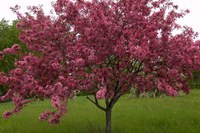 |
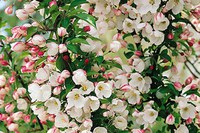 |
| 'Adams' | 'Adirondack' |
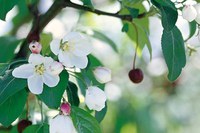 |
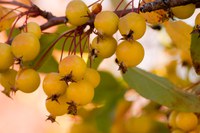 |
| 'Donald Wyman' | 'Harvest Gold' |
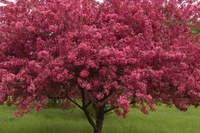 |
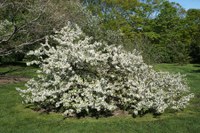 |
| 'Prairifire' | 'Sargent' |
One of the most beautiful sights in spring is a blooming crabapple. They are spectacular!
It’s no wonder the crabapple is the favorite small tree in North Dakota. If you go to a garden center, you will find lots of different crabapple cultivars available.
Which one is best for you? Here are some tips to help you make a choice.
Hardiness. This is always the first consideration when selecting a tree. It makes no sense to buy a tree that will die over winter. All crabapple cultivars discussed in this article are hardy to Zone 4. If you live in the far northern area of the state, focus on cultivars hardy to Zone 3.
Flower Color. This is usually the key factor. Pink or white? Besides your personal color preference, keep in mind where the tree will be planted. What is the background? For example, a white-blossomed tree will be less showy if the background is a white building. Likewise, a tree with dark pink flowers may not contrast well against a red brick building.
Fruit Persistence. This is very important! Why do we focus so much on flower color? The flowers will remain on the tree for only a couple weeks. I encourage you to consider how long the fruits persist on the tree. Some cultivars have fruit that persist on the tree through much of the fall and winter, adding color to our landscapes for several months. Cultivars known for their persistent fruits include ‘Adams’, ‘Adirondack’, ‘Donald Wyman’, Harvest Gold®, ‘Prairifire’, ‘Profusion’, Red Jewel®, ‘Red Splendor’, Royal Raindrops®, ‘Sargent’ and Sugar Tyme®.
Fruit Size. Smaller is better. Larger fruits generally create bigger messes when they drop. Avoid cultivars with fruits that are 2/3 inch or larger in diameter. Pea-sized fruits are much less messy and often stay on the tree longer.
Lack of Fruit. For gardeners who hate the mess created by dropping fruits, sterile cultivars are available, namely Marilee® and ‘Spring Snow’. Sterile trees are most useful in patios and courtyards.
Fruit Color. We automatically think crabapple fruits are red, but some cultivars produce golden yellow fruits. That’s special. These cultivars include Cinderella®, Harvest Gold®, Lollipop® and ‘Louisa’.
Not all red fruits are the same. Some red fruits are dark and dull. Others are brilliant. Cultivars with the brightest fruits include ‘Adirondack’, ‘Donald Wyman’, Red Jewel® and ‘Sargent’.
Foliage Color. Trees with purple or bronze foliage will stand out and make an eye-catching statement in the landscape. These cultivars include ‘Cardinal’, Gladiator™, ‘Prairifire’, ‘Purple Prince’, ‘Royal Beauty’ and ‘Royal Raindrops®’.
On the other hand, a crabapple with green foliage can provide a more natural, relaxing effect in landscapes.
Tree Shape. Many cultivars have a rounded canopy, but some have upright to columnar canopies suitable for tight spaces. These include ‘Adirondack’, Gladiator™, Ivory Spear™ and ‘Marilee®’.
A few cultivars (‘Louisa’, ‘Royal Beauty’ and Ruby Tears™) have graceful, weeping habits; this can make a statement as a specimen tree in your landscape.
‘Sargent’ is a great choice if you are looking for a dwarf (8-foot-high) tree with a horizontal habit.
Resistance to Disease. Look for trees that resist diseases. It’s heart-breaking to have a crabapple tree that drops its leaves in mid-summer due to scab disease or dies prematurely from fire blight. Scab is more of a problem in the eastern part of our state because of its higher humidity.
More Information. Look over the online charts of Johnson’s and J. Frank Schmidt nurseries. Most local nurseries get their products from Bailey Nursery. Go to their website, type in “crabapple”; and learn about their selections.
Crabapple cultivars have been reviewed by NDSU researchers for decades. The authoritative publication that describes their work is Choice Flowering Crabapple Cultivars for the Northern Plains.
The following chart is a summary of the some of the finest crabapple cultivars for North Dakota. Available as PDF.
| CULTIVAR | ZONE | H | W | SHAPE | FOLIAGE | FLOWER | FRUIT | SCAB | FIREB |
| Adams | 4 | 20 | 20 | Rounded | Green | Pink | Red; 5/8"; persistent | Good | Excel. |
| Adirondack | 4 | 18 | 12 | Upright | Green | White | Bright red; 1/2"; abundant; persistent | Excel. | Exc. |
| Cardinal | 4 | 15 | 20 | Spreading | Dark red, glossy | Deep pink-red | Deep red; 1/2" | Excel. | Good |
| Cinderella® | 4 | 8 | 5 | Oval | Dark green, cut | White | Yellow; 1/4"; persistent | Fair | Excel. |
| Donald Wyman | 4 | 20 | 25 | Rounded | Green, glossy | White | Bright red; 3/8"; abundant; persistent | Good | Fair |
| Firebird® | 4 | 10 | 10 | Rounded | Dark green | White | Bright red; 3/8"; persistent | Excel. | Excel. |
| Gladiator™ | 2 | 20 | 9 | Upright | Bronze-purple | Bright pink | Red-purple; small | Good | Good |
| Harvest Gold® | 4 | 20 | 20 | Rounded | Dark green | White | Gold; 1/2"; persistent | Fair | Fair |
| Ivory Spear™ | 4 | 18 | 7 | Narrow | Dark green | White | Bright red; 1/2" | Excel. | Excel. |
| Lollipop® | 4 | 10 | 10 | Rounded | Green | White | Gold-yellow; 3/8" | Good | Good |
| Louisa | 4 | 10 | 12 | Weeping | Dark green, glossy | Pink | Gold-yellow; 3/8" | Good | Good |
| Marilee® | 4 | 24 | 10 | Narrow | Green | Double white | Nearly sterile | Good | Good |
| Perfect Purple | 4 | 20 | 20 | Rounded | Deep purple | Deep pink-rose | Purple-red | Fair | Fair |
| Prairifire | 4 | 20 | 20 | Rounded | Ages to red-green | Bright magenta | Maroon; 1/2"; persistent | Excel. | Good |
| Profusion | 4 | 20 | 20 | Upright | Ages to bronze | Red-purple | Maroon; 1/2"; persistent | Fair | Good |
| Purple Prince | 4 | 20 | 20 | Rounded | Ages to bronze-green | Rose-red | Maroon; 1/2" | Excel. | Good |
| Red Jewel® | 4 | 15 | 12 | Upright | Dark green | White | Bright red; 1/2"; persistent | Good | Fair |
| Red Splendor | 3 | 23 | 20 | Upright | Ages to green | Bright pink | Bright red; 1/2"; persistent | Good | Fair |
| Royal Beauty | 3 | 10 | 8 | Weeping | Purple | Dark pink | Dark red; 1/2"; persistent | Good | Excel. |
| Royal Raindrops® | 4 | 20 | 15 | Upright | Purple, cutleaf | Bright pink-red | Red; 1/4"; persistent | Excel. | Good |
| Ruby Dayze® | 4 | 22 | 16 | Upright | Ages to bronze | Bright magenta | Deep red; 1/4" | Excel. | Excel. |
| Ruby Tears™ | 4 | 8 | 13 | Weeping | Burgundy-green | Pink | Dark red; 3/8" | Good | Excel. |
| Sargent | 4 | 8 | 12 | Horizontal | Dark green | White | Bright red; 1/4; abundant; persistent | Excel. | Excel. |
| Show Time™ | 3 | 22 | 20 | Rounded | Bronze-green | Bright pink-red | Red; 1/2" | Fair | Good |
| Spring Snow | 4 | 25 | 20 | Oval | Bright green | White | Nearly sterile | Poor | Fair |
| Sugar Tyme® | 4 | 18 | 15 | Oval | Green | White | Red; 1/2"; persistent | Excel. | Good |
| Tina | 4 | 6 | 8 | Rounded | Dark green, small | White | Bright red; 1/4" | Excel. | Good |
Written by Tom Kalb, Extension Horticulturist, North Dakota State University. Photos courtesy of keeva999 (home page), Bailey Nursery and Plant Image Library.
Information from the above chart was obtained from similar charts from Johnson's Nursery and J. Frank Schmidt and information from Bailey Nursery.
Most local nurseries get their products from Bailey Nursery. Learn about all of their selections.





